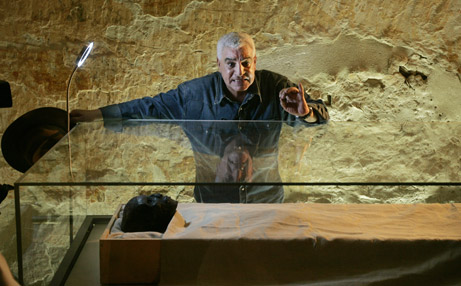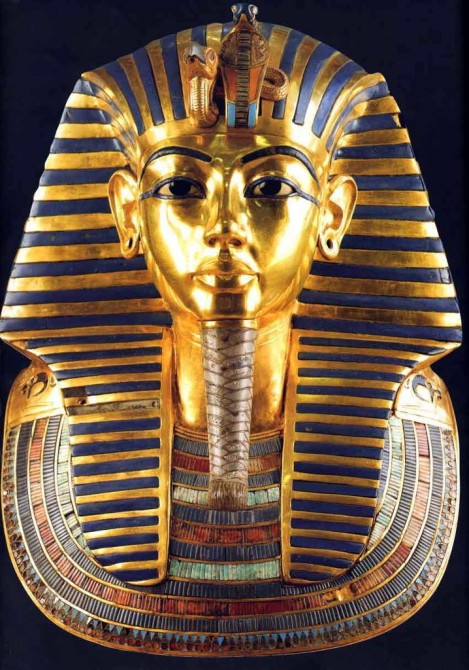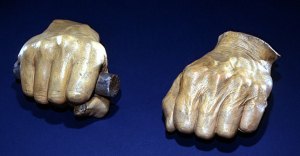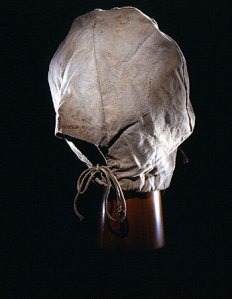June 17, 2009: Barry Cauchon
Hi all: In 2004-2005, I was the Sr. Project Manager for the current King Tut exhibit (which I affectionately call Tut 1). And although I am no longer working on that project, I do keep up with the folks involved and see how things are going from time to time. So I thought I’d give you an update on what is happening. The two King Tut tours are on the move once again.
Tut 1 called Tutankhamun and the Golden Age of the Pharaohs will open on June 27, 2009 in San Francisco at the de Young Museum. The exhibit is currently scheduled to run until March 28, 2010. The city is abuzz with excitement about having the exhibit back in town. The de Young Museum was one of seven museums in the United States that hosted the original King Tut exhibit back in the 1970s.

Tutankhamun and the Golden Age of the Pharaohs first opened in Basel, Switzerland in 2004, followed by a run in Bonn, Germany. The tour was then taken over by a group from the United States (Arts and Exhibitions International, AEG Live and the National Geographic Society) and opened its first show n Los Angeles in June, 2005. The following cities have hosted the exhibit:
- Los Angeles, CA
- Fort Lauderdale, FL
- Chicago, IL
- Philadelphia, PA
- London, England
- Dallas, TX
- and now is headed to San Francisco
Tut 2 called Tutankhamun: The Golden King and the Great Pharaohswill open on June 27, 2009 in Indianapolis, Indiana at the Childrens’ Museum of Indianapolis. It is currently scheduled to run until October 25, 2009. From there, the tour will continue to Toronto, Ontario, Canada and run from November 24, 2009 to April 18, 2010.

This tour began in Vienna, Austria at the Volkerkunde Museum Vienna and was on display from March 9, 2008 to September 28, 2008. It was exhibited under the name Tutankhamun and the World of the Pharaohs. After that, the show traveled to the United States and now is named Tutankhamun: The Golden King and the Great Pharaohs. The exhibit has, or will visit the following cities:
- Vienna, Austria (ended)
- Atlanta, GA (ended)
- Indianapolis, IN (opening June 27, 2009)
- Toronto, ON, Canada (opening November 24, 2009).
Both Tut 1 and Tut 2 each have over 130 objects from a variety of Egyptian sites including 50 of which come from Tutankhamun’s tomb.
What these exhibits ARE NOT displaying
Two of the biggest misconceptions about these two exhibits are that the following artifacts are included and on display:
- King Tut’s mummy
- Golden Mask
This is absolutely not the case. Regrettably, neither of these artifacts are included in the current tours. In fact, Tutankhamun’s mummy has never even left its tomb in the Valley of the Kings in Luxor, Egypt since its discovery in 1922. And although thousands of people visit the tomb annually, the mummy was never on public display there until November of 2007. It was then that King Tut’s mummy was put in a special climate-controlled display case inside the tomb where visitors are now able to view it.

Zahi Hawass, Egypt's Secretary General of the Supreme Council of Antiquities (SCA) stands over the mummy of Tutankhamun now on display in his tomb in the Valley of the Kings, Luxor, Egypt.
The Golden Mask is also not on tour with these two exhibits. It remains on display at The Egyptian Museum in Cairo. However the mask was part of the original exhibit Treasures of Tutankhamun that toured in the 1970s. Many people remember that blockbuster exhibit because of the Golden Mask and they assumed that it would tour again with these new shows. Unfortunately the Egyptian government stated that it would never again allow the mask to leave Egypt as it is considered a national treasure and must remain safely in Egypt.
The icon often used in the current advertisements for these new exhibits confused many people because it looks like the Golden Mask but in fact is a “golden canopic coffinette”. The coffinettes (4 in total) were used to hold one of Tutankhamun’s internal organs after the embalming process was completed. They are amazing in detail to see in person. They have similar features to the Golden Mask but are tiny in comparison. The head and shoulders of the Golden Mask is 54cm high (21-1/4″) while the height of an entire canopic coffinette only measures 39cm high (15-3/8″). Each exhibit has one of these coffinettes on display.

King Tut's Golden Mask is not on tour and remains in The Egyptian Museum in Cairo.

Canopic coffinette. Each touring exhibit features one of these wonderfully intricate artifacts which are only 15-3/8" tall.
To buy tickets to the exhibits, go to www.kingtut.org.

























